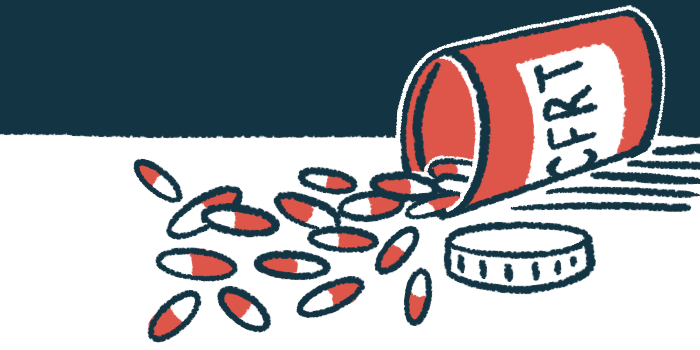#NACFC2022 – Smoking Exposure Can Limit Effectiveness of Kalydeco
Smoke-exposed patients saw less improvement in lung function, quality of life

Exposure to tobacco smoke may reduce the effectiveness of Kalydeco (ivacaftor), a CFTR modulator that is widely approved to treat cystic fibrosis (CF) caused by specific mutations.
That’s according to data shared by Gabriela Oates, PhD, at the 2022 North American Cystic Fibrosis Conference, taking place Nov. 3–5 in Philadelphia. The presentation was titled “Tobacco smoke exposure reduces the clinical efficacy of ivacaftor: Results from the G551D observational trial (GOAL).” The work was funded by the National Institutes of Health and the Cystic Fibrosis Foundation.
It’s well-established that tobacco smoke can have negative long-term effects on lung health. Some data suggest that tobacco smoke may reduce the expression and functionality of CFTR, the gate-like protein whose deficit causes CF. About 30% of CF children in the U.S. are exposed to tobacco smoke, according to caregiver reports, which is particularly noteworthy as any exposure to tobacco smoke carries risk, Oates noted.
Kalydeco works by ‘propping open the gate’ in CFTR protein
Kalydeco is a CFTR modulator that works to “prop open the gate” in the CFTR protein, helping to improve the protein’s functionality in people with certain CF-causing mutations. The medication is widely approved to treat eligible patients with certain mutations, and is also included as a part of other therapies that combine CFTR modulators.
Since tobacco smoke may reduce the functionality of the CFTR protein, it could theoretically make CFTR modulators like Kalydeco — which work directly on the CFTR protein — less effective. A team led by scientists at the University of Alabama at Birmingham conducted an analysis to test this idea.
The researchers analyzed urine samples collected from 142 people with CF, ages 6 to 59, all of whom had a disease-causing mutation known as G551D. The samples were collected as part of an observational clinical trial called GOAL (NCT01521338), which tracked outcomes for people with CF caused by mutations that interfere with the gate-like activity of the CFTR protein.
Smoking cessation interventions tailored to people with CF and their families may optimize the therapeutic benefit of [highly effective modulator therapies]
Using a chemical analysis technique called liquid chromatography with tandem mass spectrometry, the researchers analyzed levels of two tobacco-related molecules in the patients’ urine: NNAL, a metabolite of nicotine (the highly addictive chemical in tobacco), and 3-HPMA, a metabolite of acrolein, the most significant contributor to the noncancer respiratory effects of cigarette smoke.
The 41 patients with elevated levels of both NNAL and 3-HPMA were classified as “exposed” to tobacco smoke, while 71 patients with low levels of both molecules were “unexposed.” The remaining 30 patients had low levels of NNAL and moderate levels of 3-HPMA, and were classified as “undetermined.”
As a measure of treatment efficacy, the researchers looked at levels of chloride in patients’ sweat — people with CF generally have elevated sweat chloride levels, and testing these levels is commonly used to assess CFTR protein function and confirm a CF diagnosis.
While no differences were found at the start of the study, the average sweat chloride level was significantly lower after six months on Kalydeco in patients who were unexposed to tobacco smoke, compared to exposed patients: 42.25 vs. 58.48 millimole per liter (mmol/L). The average decrease in sweat chloride levels over time was significantly greater in unexposed patients (58.8 mmol/L) compared to exposed patients (44.7 mmol/L).
Smoke-exposed patients experience significantly less lung function improvement
Statistical models, which accounted for age and clinical characteristics upon starting treatment, showed that smoke-exposed patients experienced significantly less improvement in a measure of lung function called forced expiratory volume in one second: after six months of treatment, patients exposed to tobacco smoke improved by 4.5% less, on average.
Similarly, smoke-exposed patients saw an average of 6.8 points less improvement on the Cystic Fibrosis Questionnaire Revised respiratory scale, a measure of health-related quality of life.
“[Tobacco smoke exposure] limits the clinical efficacy of ivacaftor [Kalydeco],” said Oates, who suggested that smoking cessation be included in the multidisciplinary care of CF patients.
“Smoking cessation interventions tailored to people with CF and their families may optimize the therapeutic benefit of [highly effective modulator therapies],” she said.
Note: The Cystic Fibrosis News Today team is providing in-depth coverage of the 2022 North American Cystic Fibrosis Conference (NACFC) Nov. 3–5. Go here to see the latest stories from the conference.









